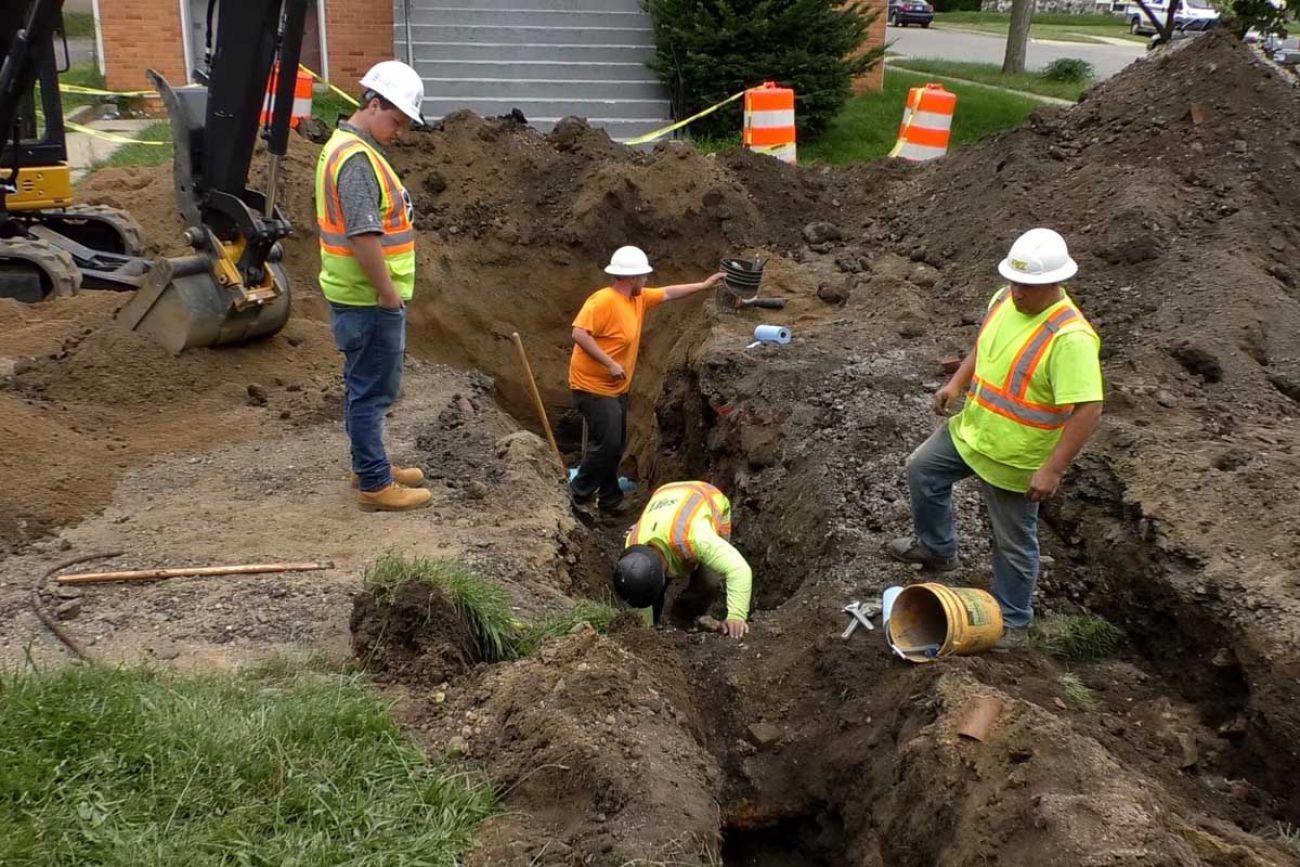How Michigan communities can, and should, spend billions in Biden stimulus

May 11: Fun for Michigan governments: How to spend $11 billion in federal stimulus
LANSING—Government officials across Michigan are confronting something of a welcome challenge this spring: The need to design programs and systems to maximize billions of dollars in federal stimulus funding heading their way — and spend it down before the federal government can take it back at the end of 2024.
“We’re going to have to buy buckets to hand out money from,” Ingham County Commissioner Mark Grebner joked in March after learning Ingham is in line for nearly $57 million from the federal government.
“Maybe we could have parades and throw dimes at children?”
Related:
- Child tax credits are expected to start arriving in July. Here’s what to know.
- Biden COVID stimulus brings billions to Michigan. How much will your town get?
- How $1.9 trillion COVID stimulus plan will impact Michigan
- ‘Huge’ COVID stimulus could lift 117,000 Michigan children out of poverty
- COVID reveals Michigan’s internet broadband gap. Will take years to close.
Michigan cities, townships, villages and counties are expected to receive a combined $4.4 billion from the latest COVID-19 stimulus package signed into law last month by President Joe Biden, according to initial estimates. Half the money should reach local governments this year, with the other half arriving in 2022.
That's the equivalent of $441 for each of Michigan's roughly 10 million residents, many of whom already qualified for their own $1,400 stimulus checks.
All told, the $1.9 trillion federal stimulus plan is expected to provide $10 billion for governments across Michigan: the $4.4 billion for local governments plus another $5.6 billion for state government, which Democratic Gov. Gretchen Whitmer and the Republican-led Legislature will need to negotiate.
And that’s separate from Biden’s $2 trillion infrastructure proposal unveiled last week.
Experts say the “rescue plan” presents huge opportunities for local government officials to not only meet immediate needs and rebuild economies that suffered during the pandemic, but to also think long-term, with an eye on equity, and begin to invest in infrastructure that will last decades beyond the public health crisis.
“It’s hard to exaggerate how big of a deal it is,” said Stephanie Leiser, who leads the Local Fiscal Health Project at the University of Michigan’s Center for Local, State, and Urban Policy.

“I’ve heard it compared to the New Deal, and I think this is a good way for communities to kind of frame this, as a really big injection of resources, and probably not one they’re likely to get again for a long time.”
The federal stimulus law includes some restrictions on how the money can be spent — states can’t use it to cut taxes, and local governments can’t prop up struggling pension funds — although it is more flexible than earlier stimulus packages. Officials are awaiting additional guidance, as well as exact funding levels, from the U.S. Treasury, which they expect by early May.
But spending discussions have already begun as officials anticipate funding that in some cases will rival their annual operating budgets.
The immediate priority is “taking care of people,” but beyond that, local governments should focus on making “generational change,” said state Sen. Adam Hollier, a Detroit Democrat who has a master’s degree in urban planning. “And if we're talking generational change, it's real infrastructure. That's removing lead and copper lines, and taking those out.”
The stimulus also includes ambitious national programs that could lift 117,000 Michigan children out of poverty, and additional funding for tribal communities. There’s also money for local transit systems in Michigan, including $250 million for cities from Benton Harbor to Saginaw, and another $20.6 million for rural transit agencies.
Some local governments will focus their spending on immediate business or resident relief programs to help restore the pre-pandemic economy, and that’s reasonable given the number of businesses and people that “got crushed” financially over the past year, said Lou Glazer, president of Michigan Future Inc., a nonprofit focused on encouraging a “knowledge-driven” economy.
“But the wisest use of this money is to try to begin to make structural reforms” that will last for years, Glazer said. “What are the basic services, infrastructure and amenities that they have underinvested in, probably for decades, that are needed to be an attractive place where people live, work and play?”
Here's what we know so far about how the money can be spent — and how a variety of experts say it should be spent to maximize its impact.
Relief programs for businesses, residents
The first “traunch” of federal funding is expected to reach local governments by May, and experts say officials should work to deploy that money as quickly as possible to benefit those impacted by the ongoing pandemic.
The federal law allows local governments to use funding for “costs related to the public health emergency, including assistance to households, small businesses, nonprofits and aid to affected industries like tourism, travel and hospitality.”
That means cities, townships, villages and counties across Michigan could set up their own relief programs and hand out grants, either directly to local businesses or households, or through partnerships with nonprofits and other community organizations.
“I think we're all in the business now of seeking the names of desperate restaurant owners,” said Grebner, the Ingham County Commissioner. “The real point of this stimulus package at the local level is giving it to people and businesses in need, and this is a process that is going to be controlled by the local units of government, which do not have any system for doing that.”
Setting up those systems will require local governments to identify residents or businesses that struggled in the pandemic. Some could have a head start on that front if local businesses have already applied for other relief programs earlier in the pandemic. Then they’ll also need to build systems to hand out the grants, partner with industry groups or build regional collaborations, which have generally been elusive in Michigan.
The federal law prohibits states from using the stimulus funding to directly or indirectly pay for new tax cuts or delay any pending tax increases. But that prohibition does not apply to local governments, which could choose to lower property taxes or other assessments.
Business or resident relief programs could take a variety of forms, said Chris Hackbarth, director of state and federal affairs for the Michigan Municipal League.
Some communities may decide to use the funding to reimagine their downtowns with more spaces for outdoor gatherings, which some already did during the pandemic to help restaurants and bars attract customers who were wary of eating or drinking inside, he said.
“I’m sure some businesses will start rethinking how they can model themselves to be year-round,” Hackbarth said. “Their communities have an ability to help them with some of that.”
Pandemic expenses and hazard pay
Unlike prior pandemic stimulus plans, the American Rescue Act allows local governments to use the funding to plug budget holes caused by revenue declines during the pandemic.
The size of those budget holes — and therefore the ability to spend the funding to fill it — “is kind of all over the place,” said Leiser of U-M. “Communities that are mostly reliant on property taxes have fared better than the ones who have more reliance on income tax or the kind of excise taxes on tourism-related things and have more of a gap to fill in.”
The 24 Michigan communities that impose a local income tax are facing a combined loss of $250 million in revenue this year alone, according to Hackbarth of the Municipal League. That’s because residents who lost jobs during the pandemic no longer had an income subject to being taxed, and others who transitioned to remote work may no longer have reported to an office in the cities with a tax.
Detroit, the state's largest city, reportedly lost $170 million in expected income taxes, part of a $410 million million revenue loss since the pandemic began in March of 2020.
Other cities with a local income tax include: Albion, Battle Creek, Benton Harbor, Big Rapids, East Lansing, Flint, Grand Rapids, Grayling, Hamtramck, Highland Park, Hudson, Ionia, Jackson, Lansing, Lapeer, Muskegon, Muskegon Heights, Pontiac, Port Huron, Portland, Saginaw, Springfield and Walker.
Communities like Southfield, Troy, Utica and Auburn Hills in metro Detroit, with a large concentration of commercial office space, may still face a major budget hit in coming months as local businesses appeal their property tax assessments, Hackbarth said.
The stimulus also allows local governments to use funds to provide hazard pay to government workers who “performed essential functions during the public health emergency.” Specifically, the money can be used to provide up to $13 an hour in “premium pay” to those employees, who are barred from receiving more than $25,000 total.
The U.S. Department of Treasury has not yet provided local governments with additional guidance on who can qualify for that hazard pay, but it’s expected that officials will be able to provide back pay to many workers who stayed on their job during the pandemic.
At the county level, that could mean extra pay for sheriff’s deputies, health department workers and jail guards. At the city level, local police, fire and paramedics could benefit.
And it might even mean extra pay for “people who didn’t know they were going to get it and hadn’t even asked for it” but may now qualify, such as 911 operators, said Grebner, the Ingham County Commissioner. “Maybe we won't, but it's the sort of thing we're thinking about, because it's permitted.”
The federal law includes one big prohibition for local governments: They cannot use the stimulus funding to prop up pension systems or pay down unfunded liabilities that pose major budget challenges for communities in some parts of the state.
But using stimulus funding to fill a hole in one part of the budget could ultimately free up resources for those other priorities, Leiser said. “This will give them some breathing room to make it easier to do that in the long-run.”
Lead service lines and clean water
The federal law allows local governments to use the stimulus funding to make “necessary” investments in water infrastructure, and that is a “huge opportunity to focus on clean water,” said Justin Onwenu, a Detroit-based environmental justice organizer for the Sierra Club.

Local governments could use the funding to replace lead service lines, whose dangers were exposed in the Flint water crisis, for instance. Or they could build new water treatment plants, and Onwenu said officials may also be able to fund water affordability programs.
A new rule adopted in the wake of the Flint water crisis requires public water systems across the state to replace any lead service lines that still remain in the ground. That process began in January, and the state is giving them 20 years to complete the job.
Whitmer last year announced $139.6 million in funding to help communities comply with the rule change and called on state lawmakers to free up more money. But available resources have paled in comparison to the likely cost.
There are nearly 100,000 known lead service lines still in use in Michigan — and that's only in the 148 communities that are certain what kind of pipes they have underground.
Another 56 public water systems suspect they have at least some lead service lines, and another 65 simply do not know what is underground and may have to dig to confirm, according to preliminary inventories submitted to the state last year.
All told, there are nearly 300,000 known or suspected lead service lines in Michigan, and 275,000 pipes made of unknown materials with no available documentation. There are another 560,000 pipes without documentation that officials believe are not likely to contain lead.
Grand Rapids, the state’s second largest city, reported 18,557 known lead service lines and another 8,540 it suspects are made of lead. Saginaw and Jackson each reported more than 10,000 known lead service lines. Detroit reported 2,420 known lead pipes but more than 77,000 it suspects are also made of lead.
The stimulus funding could help local communities “accelerate” lead service line replacement initiatives they were already planning, Leiser said. “It’s sort of a remedial thing, as opposed to kind of investing in 21st Century infrastructure, but we only have to look to the Flint water crisis to see what are the effects of not maintaining basic infrastructure.”
The pandemic showed the importance of access to clean water, Onwenu said, noting that Whitmer issued a statewide order imposing a moratorium on water shutoffs to protect residents who had lost jobs and couldn’t pay their water bills.
“I think the theme of this moment is that there have been a lot of issues that have been festering for a long time, and COVID just sort of ripped the mask off of these issues,” Onwenu said. “Hopefully this is the chance to get the funding to get some real work done.”
The Michigan Legislature extended the shutoff moratorium, but that law expired Thursday, eliminating a statewide safeguard for both residents and businesses who may still be struggling to pay water bills.
Some communities have already extended their own local moratoriums, including Detroit, where Mayor Mike Duggan has said the city will not shut off any residential water customers through at least 2022.
Upgrading water infrastructure is a good investment because it can help local governments save money in the long run, said Hackbarth, of the Municipal League.
“You’ve got some communities that are fighting constant water main breaks,” he said. “If you get funds now and you can do that rebuild, then your maintenance” costs will go down.
Broadband expansion
The federal law also allows local governments to spend stimulus funds on broadband infrastructure, which could especially benefit rural residents whose homes still aren’t connected to fiber optic cables and can also struggle with poor cell phone reception.
The Whitmer administration estimates as many as 1.2 million households — 1-in-4 statewide — lack a permanent fixed broadband connection. Existing state and federal grant programs aim to close that digital divide, but experts have predicted it could still take years to close.
The pandemic further exposed the broadband gap in everything from school instruction to office work moved online. And some of those changes — including new corporate flexibility for remote work — will likely continue even after the pandemic ends.
“Broadband is probably one of the most important areas of investment going forward in the post-pandemic economy, where reliance on internet and connectivity is absolutely vital,” Leiser said.
“There’s been a lot of emphasis on fixing the damn roads in Michigan, and that continues to be important. But I think this is kind of a once-in-a-lifetime injection of resources and thinking long-term and thinking big about it is going to pay off. Investment in broadband infrastructure would be a really important use of this money, especially in more rural parts of the state.”
(Note: The federal stimulus plan will only allow local governments to spend on roads to the extent they lost tax revenue they would have used for that purpose. In other words, the stimulus is not going to “fix the damn roads,” but Biden has proposed a separate $2 trillion infrastructure plan hat includes funding for roads and bridges, along with billions in additional funding for broadband expansion and water infrastructure.)
The rush to extend broadband service or lead service line replacements could lead to competition for installers among local governments, driving up the price of labor and supplies. And that’s why “regional coordination and capacity building is going to be absolutely essential,” Leiser said. “If you don’t know what your neighbors are doing, then you can be kind of working at odds.”
That happened at the national level early in the pandemic as states were bidding against each other for personal protective equipment because “there was no federal coordination to prevent that from happening,” she added. It was one of the “biggest failures of the pandemic.”
Upgrade sewer systems
Aging sewer infrastructure is also a major challenge for some Michigan communities, and the federal law will allow stimulus funding to be used for "necessary" upgrades to those systems as well.
Environmental groups have been sounding alarms for years over decrepit sewer systems, leaking pipes and failing sewage treatment plants that contribute to the estimated 5.7 billion gallons of raw sewage that is dumped into Michigan waterways each year.
“There is no shortage of investments that can be made in underground infrastructure,” said Hackbarth, of the Municipal League.
While it is not specified, the National League of Cities is using the Treasury Department to define sewer infrastructure in a way that also allows local governments to fund work on wastewater and stormwater systems.
Aging septic systems, which are often used in rural areas without access to a municipal water supply, also pose risks in some parts of the state. As of 2016, 10 percent of Michigan's 1.3 million septic tanks were "experiencing operational problems," according to a state report.
Grebner, the Ingham County Commissioner, said he’s exploring the possibility of partnering with small townships to help property owners replace failing septic and well systems that can drive down property values if they are discovered by inspectors.
“Just imagine if we said to all these people that are hiding from us all this time: We got cash money,” he said. “Come out of the woods, man. You're welcome.”
See what new members are saying about why they donated to Bridge Michigan:
- “In order for this information to be accurate and unbiased it must be underwritten by its readers, not by special interests.” - Larry S.
- “Not many other media sources report on the topics Bridge does.” - Susan B.
- “Your journalism is outstanding and rare these days.” - Mark S.
If you want to ensure the future of nonpartisan, nonprofit Michigan journalism, please become a member today. You, too, will be asked why you donated and maybe we'll feature your quote next time!




